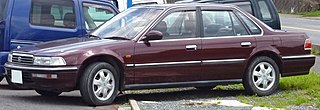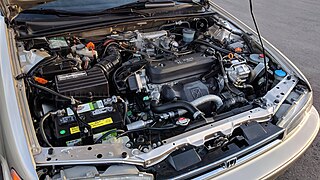
The Honda CR-X, originally launched as the Honda Ballade Sports CR-X in Japan, is a front-wheel-drive sport compact car manufactured by Honda from 1983 until 1991 with nearly 400,000 produced during this period. The first-generation CRX was marketed in some regions outside Japan as the Honda Civic CRX. Although there are many supposed definitions for the initialism CR-X, the most widely accepted is "Civic Renaissance Experimental".
The Rover Group plc was the British vehicle manufacturing conglomerate known as "BL plc" until 1986, which had been a state-owned company since 1975. It initially included the Austin Rover Group car business, Land Rover Group, Freight Rover vans and Leyland Trucks. The Rover Group also owned the dormant trademarks from the many companies that had merged into British Leyland and its predecessors such as Triumph, Morris, Wolseley, Riley and Alvis.

The Honda Accord, also known as the Honda Inspire in Japan and China for certain generations, is a series of automobiles manufactured by Honda since 1976, best known for its four-door sedan variant, which has been one of the best-selling cars in the United States since 1989. The Accord nameplate has been applied to a variety of vehicles worldwide, including coupes, station wagons, hatchbacks and a Honda Crosstour crossover.

The Honda Prelude is a sports car produced by the Japanese company Honda over five generations from 1978 to 2001.

The B-series are a family of inline four-cylinder DOHC automotive engines introduced by Honda in 1988. Sold concurrently with the D-series which were primarily SOHC engines designed for more economical applications, the B-series were a performance option featuring dual overhead cams along with the first application of Honda's VTEC system, high-pressure die cast aluminum block, cast-in quadruple-Siamese iron liners.

The Isuzu Aska was a nameplate used by Isuzu Motors Ltd. of Japan to denote their mid-size sedans from 1983 to 2002. Originally, the Aska was a version of GM's J-car produced by Isuzu, but later, after Isuzu pulled out of manufacturing passenger cars, the nameplate was applied to rebadged versions of the Subaru Legacy and Honda Accord sold through Isuzu's Japanese distribution network.

The Honda Ascot is a compact sedan manufactured by Honda and marketed only in Japan from 1989 until 1997. The first generation produced two versions based on the Honda Accord CB series called the Ascot and from 1993 to 1996 a "pillared hardtop" called the Ascot Innova. The Innova shared much of its mechanicals with the European-market Accord manufactured at the Honda UK facility in Swindon, England, and was essentially the badge engineered Rover 600. The second generation was a platform improvement, shared with the Japan-only sedan called the Honda Rafaga. The "Ascot" name was chosen with reference to the Ascot Racecourse and Ascot tie, in order to add the model an alleged air of class and elegance. Honda Ascot was also used on a range of one-cylinder motorcycles in the first half of the 1980s.

Automobile was an American automobile magazine founded in 1986 by a group of former Car and Driver employees, led by David E. Davis with support from Rupert Murdoch's News Corporation, using the credo No Boring Cars. From 2014-202, Automobile had been absorbed by the Motor Trend Group.

Honda's first production V6 was the C series; it was produced in displacements from 2.0 to 3.5 liters. The C engine was produced in various forms for over 20 years (1985–2005), having first been used in the KA series Legend model, and its British sister car the Rover 800-series.
The Honda B20A engine series, known as the B20A and B21A, was an inline four-cylinder engine family from Honda introduced in 1985 in the second-generation Honda Prelude. Also available in the contemporary third-generation Honda Accord in the Japanese domestic market, along with the Accord-derived Vigor, the B20A was Honda's second line of multivalve DOHC inline four-cylinder engines behind the "ZC" twin-cam variant of the ordinarily SOHC D-series, focused towards performance and displacing 2.0 to 2.1 litres.

The Honda Concerto is a car produced from 1988 to 1996. Designed to aim at European tastes, it was jointly developed by Honda and the Austin Rover Group and was introduced in Japan on 15 June 1988, and in European markets in October 1989. Japanese production finished in October 1992 and British production finished in 1995. The car was named for the musical composition and was a successor to the second generation Honda Ballade, a higher specification Honda Civic. All Japanese versions were exclusive to Japanese Honda dealerships called Honda Clio.

The Honda F-Series engine was considered Honda's "big block" SOHC inline four, though lower production DOHC versions of the F-series were built. It features a solid iron or aluminum open deck cast iron sleeved block and aluminum/magnesium cylinder head.
The 4L30-E was an automatic transmission developed and produced by General Motors. It was developed for light-duty use in longitudinal engine rear-wheel drive vehicles, replacing the similar TH180/3L30. The 4L30-E was used in many European and Japanese vehicles, including the BMW 3- and 5 Series, Isuzu Rodeo and its derivatives, and Opel Omega/Cadillac Catera. It was replaced by the 5-speed 5L40-E/5L50. The 4L30-E was built at GM's transmission plant in Strasbourg, France.
The H4 was Honda's first 4-speed automatic transmission. It is distinguished from the later H4A by its use of two rather than three shafts.
The H5 is Honda's first 5-speed automatic transmission.

The Honda Vigor is a premium sedan that was derived from the Honda Accord. It was sold in Japan through the Honda Verno dealer network from 1981 until 1995, and sold in North America from June 1991 until 1994 as the Acura Vigor. Early Vigors were more upmarket versions of the Accord, and served as Honda's flagship until the arrival of the Honda Legend. In 1989, the Vigor would differentiate itself further from the Accord with unique styling and an available longitudinal five-cylinder engine, and a twin to the Vigor was introduced with the Honda Inspire, available at Honda Clio dealerships.

The American Honda Motor Company, Inc. is the North American subsidiary of Japanese Honda Motor Company. Founded in 1959, the company combines product sales, service and coordinating functions of Honda in North America, and is responsible for distribution, marketing and sales of Honda and Acura brand automobiles, Honda Powersports products, Honda Power Equipment products, Honda Engines products, Honda Marine engines, and the HondaJet aircraft.










